
News Corp (NWSA)
We wouldn’t recommend News Corp. Not only are its sales cratering but also its low returns on capital suggest it struggles to generate profits.― StockStory Analyst Team
1. News
2. Summary
Why We Think News Corp Will Underperform
Established in 2013 after a restructuring, News Corp (NASDAQ:NWSA) is a multinational conglomerate known for its news publishing, broadcasting, digital media, and book publishing.
- Sales stagnated over the last five years and signal the need for new growth strategies
- Responsiveness to unforeseen market trends is restricted due to its substandard operating margin profitability
- Lacking free cash flow limits its freedom to invest in growth initiatives, execute share buybacks, or pay dividends


News Corp’s quality is inadequate. There are superior opportunities elsewhere.
Why There Are Better Opportunities Than News Corp
High Quality
Investable
Underperform
Why There Are Better Opportunities Than News Corp
News Corp’s stock price of $25.63 implies a valuation ratio of 26.1x forward P/E. This multiple is higher than that of consumer discretionary peers; it’s also rich for the top-line growth of the company. Not a great combination.
There are stocks out there featuring similar valuation multiples with better fundamentals. We prefer to invest in those.
3. News Corp (NWSA) Research Report: Q3 CY2025 Update
Global media and publishing company News Corp (NASDAQ:NWSA) reported Q3 CY2025 results beating Wall Street’s revenue expectations, with sales up 2.3% year on year to $2.14 billion. Its GAAP profit of $0.20 per share was 9.4% above analysts’ consensus estimates.
News Corp (NWSA) Q3 CY2025 Highlights:
- Revenue: $2.14 billion vs analyst estimates of $2.10 billion (2.3% year-on-year growth, 2% beat)
- EPS (GAAP): $0.20 vs analyst estimates of $0.18 (9.4% beat)
- Adjusted EBITDA: $347 million vs analyst estimates of $331.6 million (16.2% margin, 4.6% beat)
- Operating Margin: 56.1%, up from 10.2% in the same quarter last year
- Free Cash Flow was $4 million, up from -$31 million in the same quarter last year
- Market Capitalization: $15.03 billion
Company Overview
Established in 2013 after a restructuring, News Corp (NASDAQ:NWSA) is a multinational conglomerate known for its news publishing, broadcasting, digital media, and book publishing.
News Corp was created to focus on delivering news and media services in the digital age. At its core, it seeks to address the need for reliable news, diverse entertainment, and educational content.
The company's portfolio spans well-known news outlets such as The Wall Street Journal, TV stations, digital media platforms, and publishing houses. This wide range of perspectives and formats caters to diverse consumer preferences for both traditional and digital media.
News Corp generates revenue through advertising, licensing fees, and subscription fees. Some of its content can also be purchased on a one-off basis.
4. Media
The advent of the internet changed how shows, films, music, and overall information flow. As a result, many media companies now face secular headwinds as attention shifts online. Some have made concerted efforts to adapt by introducing digital subscriptions, podcasts, and streaming platforms. Time will tell if their strategies succeed and which companies will emerge as the long-term winners.
Competitors in the news publishing and media sector include The New York Times (NYSE:NYT), Gannett (NYSE:GCI), and The E.W. Scripps (NASDAQ:SSP).
5. Revenue Growth
A company’s long-term sales performance can indicate its overall quality. Even a bad business can shine for one or two quarters, but a top-tier one grows for years. Unfortunately, News Corp struggled to consistently increase demand as its $8.5 billion of sales for the trailing 12 months was close to its revenue five years ago. This wasn’t a great result and suggests it’s a lower quality business.
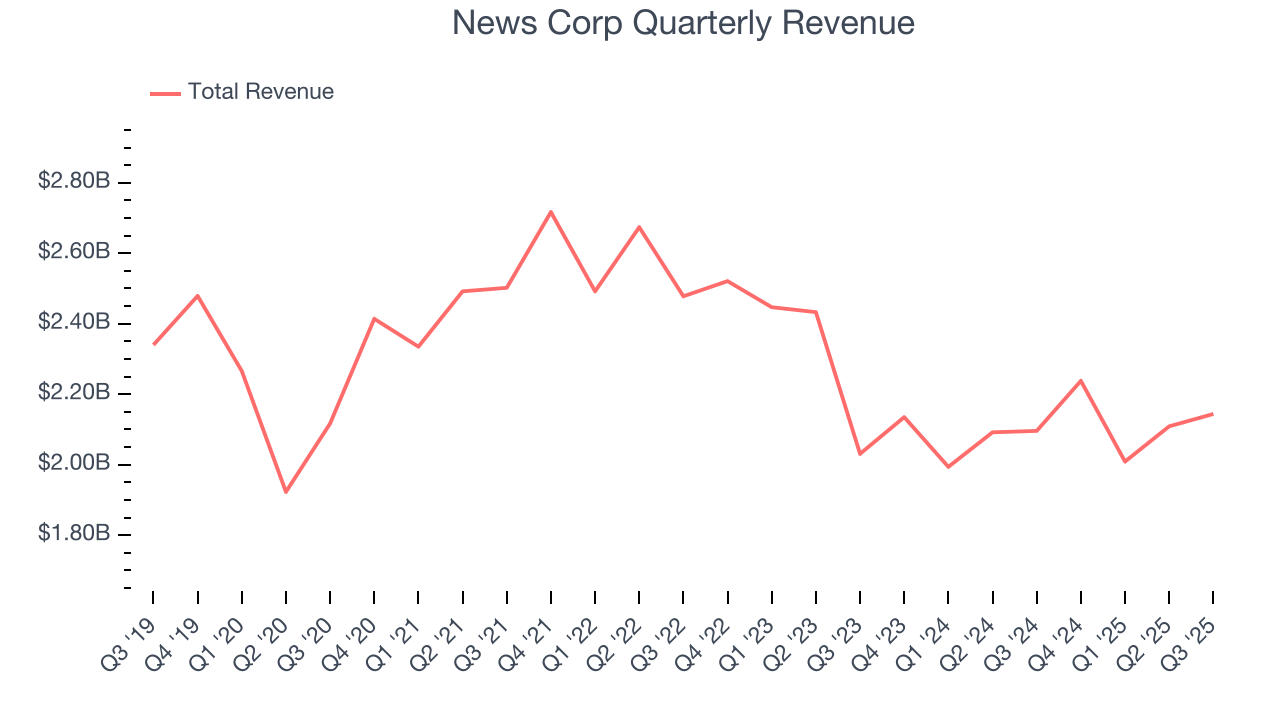
Long-term growth is the most important, but within consumer discretionary, product cycles are short and revenue can be hit-driven due to rapidly changing trends and consumer preferences. News Corp’s recent performance shows its demand remained suppressed as its revenue has declined by 5.1% annually over the last two years. 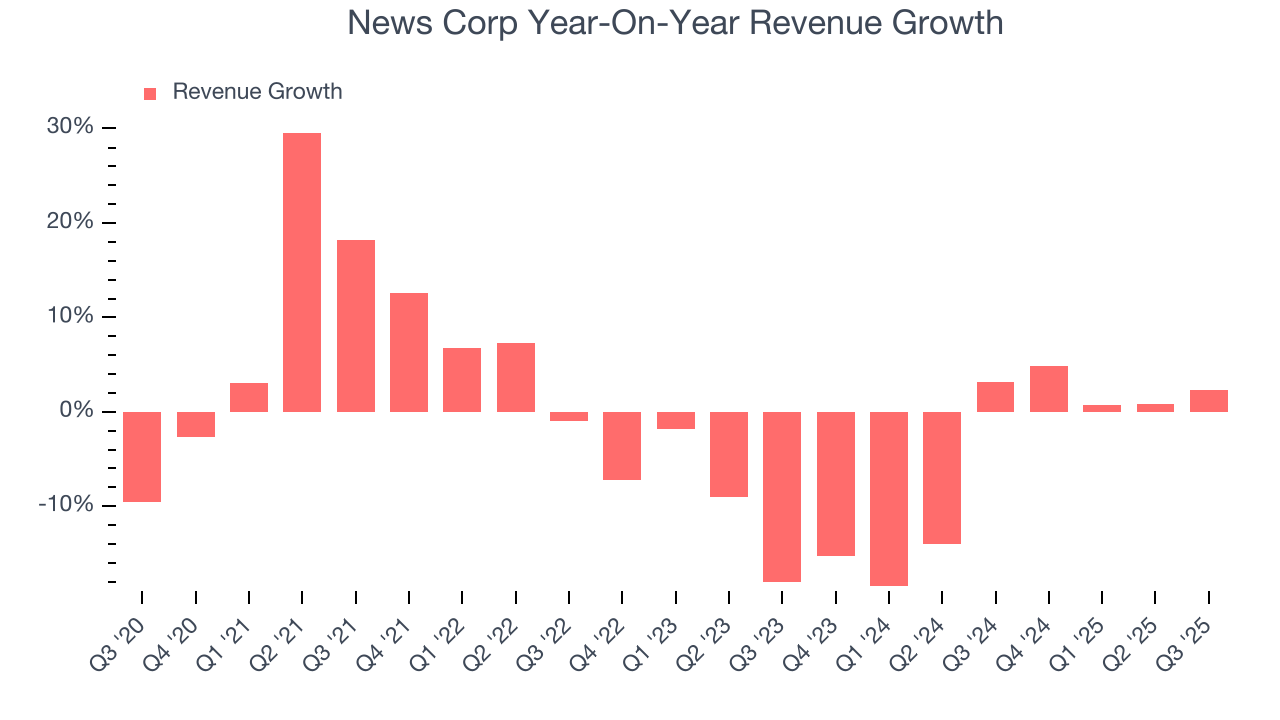
We can dig further into the company’s revenue dynamics by analyzing its three most important segments: Dow Jones, News Media, and Book Publishing, which are 27.3%, 24.9%, and 25.4% of revenue. Over the last two years, News Corp’s Dow Jones (media subsidiary) and Book Publishing (general publishing) revenues averaged year-on-year growth of 4.3% and 3.3%. On the other hand, its News Media revenue (general media) averaged 2.6% declines. 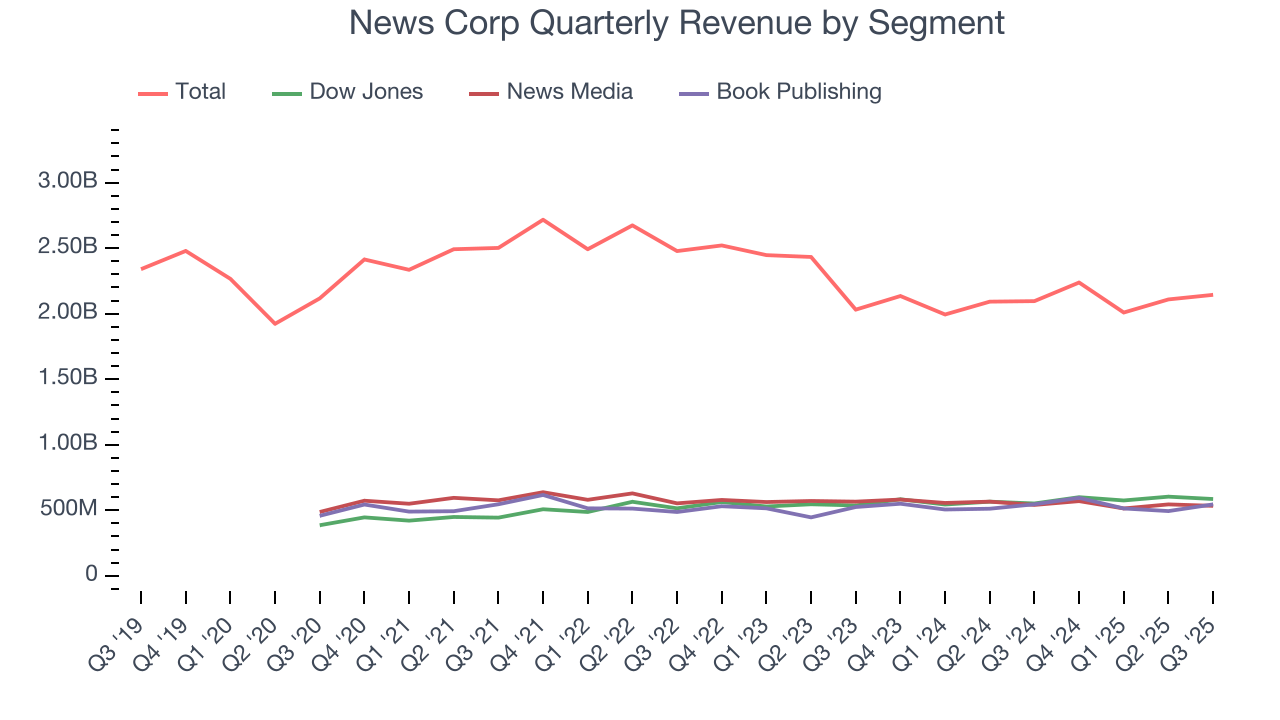
This quarter, News Corp reported modest year-on-year revenue growth of 2.3% but beat Wall Street’s estimates by 2%.
Looking ahead, sell-side analysts expect revenue to grow 2.8% over the next 12 months. While this projection implies its newer products and services will fuel better top-line performance, it is still below average for the sector.
6. Operating Margin
Operating margin is a key measure of profitability. Think of it as net income - the bottom line - excluding the impact of taxes and interest on debt, which are less connected to business fundamentals.
News Corp’s operating margin has been trending up over the last 12 months and averaged 16.5% over the last two years. On top of that, its profitability was top-notch for a consumer discretionary business, showing it’s an well-run company with an efficient cost structure.
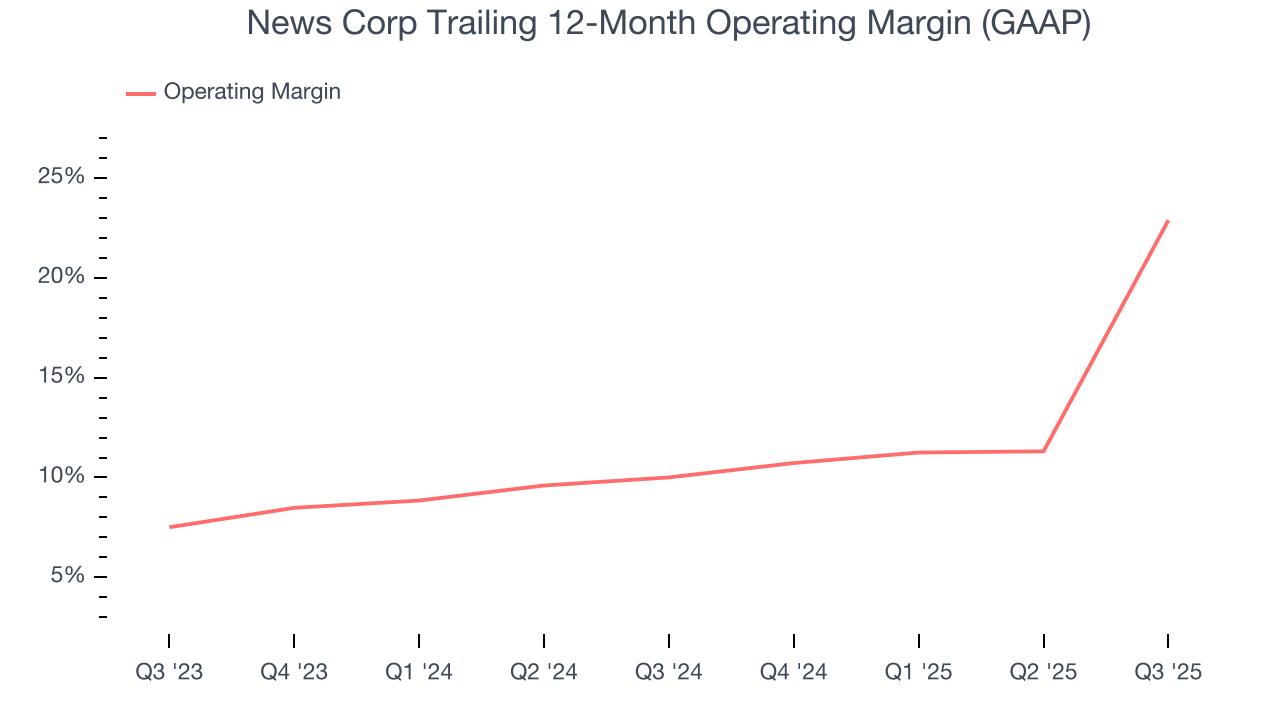
This quarter, News Corp generated an operating margin profit margin of 56.1%, up 45.9 percentage points year on year. This increase was a welcome development and shows it was more efficient.
7. Earnings Per Share
Revenue trends explain a company’s historical growth, but the long-term change in earnings per share (EPS) points to the profitability of that growth – for example, a company could inflate its sales through excessive spending on advertising and promotions.
News Corp’s full-year EPS flipped from negative to positive over the last five years. This is encouraging and shows it’s at a critical moment in its life.
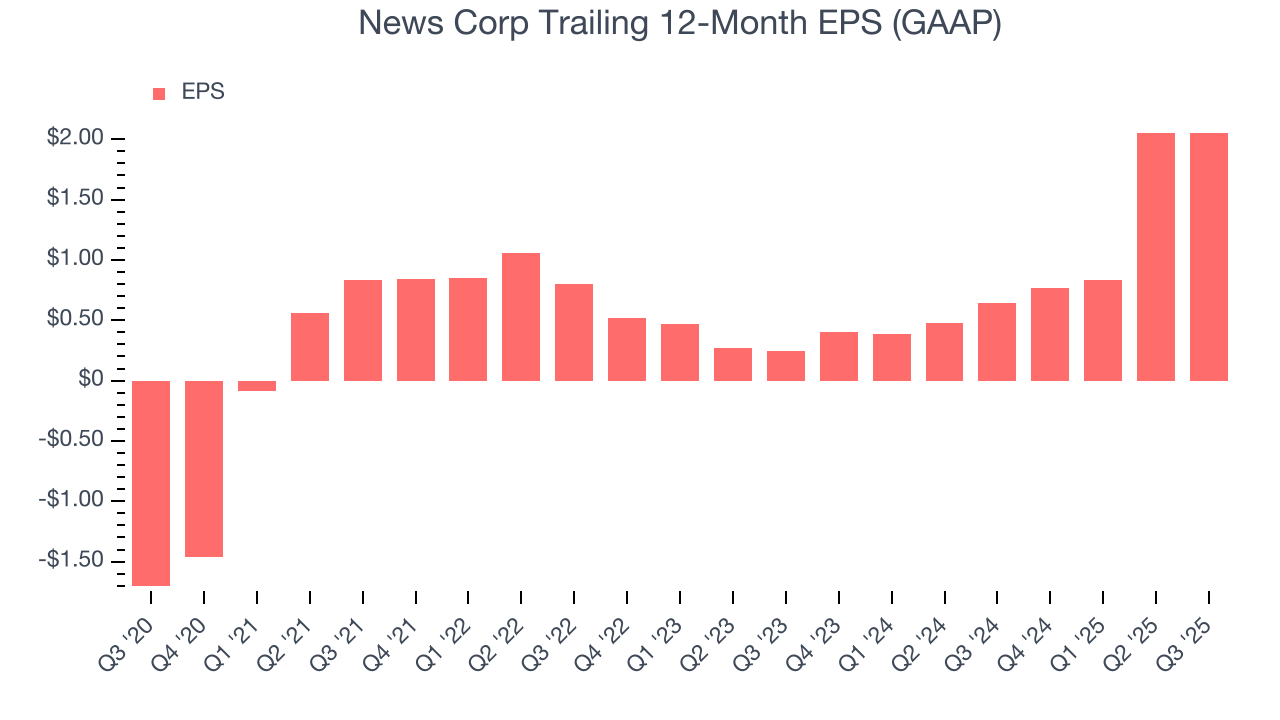
In Q3, News Corp reported EPS of $0.20, in line with the same quarter last year. This print beat analysts’ estimates by 9.4%. We also like to analyze expected EPS growth based on Wall Street analysts’ consensus projections, but there is insufficient data.
8. Cash Is King
Although earnings are undoubtedly valuable for assessing company performance, we believe cash is king because you can’t use accounting profits to pay the bills.
News Corp has shown mediocre cash profitability over the last two years, giving the company limited opportunities to return capital to shareholders. Its free cash flow margin averaged 8.1%, subpar for a consumer discretionary business. The divergence from its good operating margin stems from its capital-intensive business model, which requires News Corp to make large cash investments in working capital and capital expenditures.
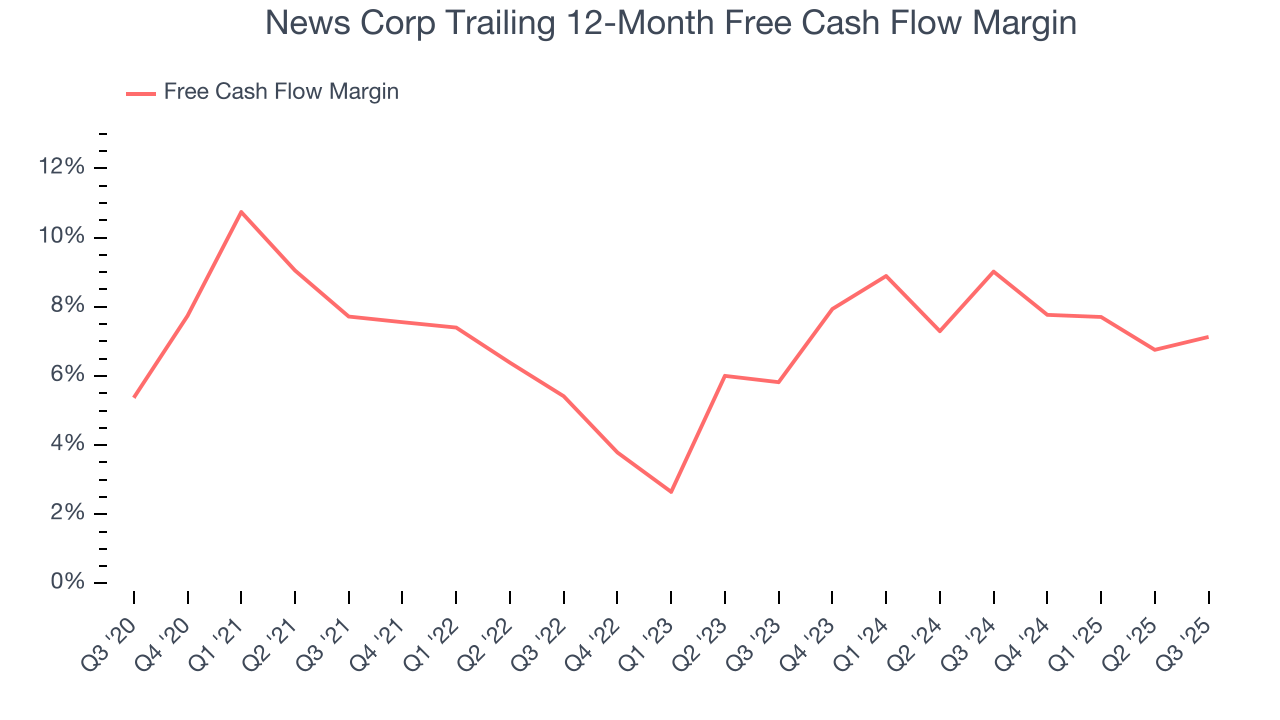
News Corp broke even from a free cash flow perspective in Q3. This result was good as its margin was 1.7 percentage points higher than in the same quarter last year, but we wouldn’t put too much weight on the short term because investment needs can be seasonal, causing temporary swings. Long-term trends trump fluctuations.
Over the next year, analysts predict News Corp’s cash conversion will improve. Their consensus estimates imply its free cash flow margin of 7.1% for the last 12 months will increase to 6.6%, it options for capital deployment (investments, share buybacks, etc.).
9. Return on Invested Capital (ROIC)
EPS and free cash flow tell us whether a company was profitable while growing its revenue. But was it capital-efficient? Enter ROIC, a metric showing how much operating profit a company generates relative to the money it has raised (debt and equity).
News Corp historically did a mediocre job investing in profitable growth initiatives. Its five-year average ROIC was 8.4%, somewhat low compared to the best consumer discretionary companies that consistently pump out 25%+.
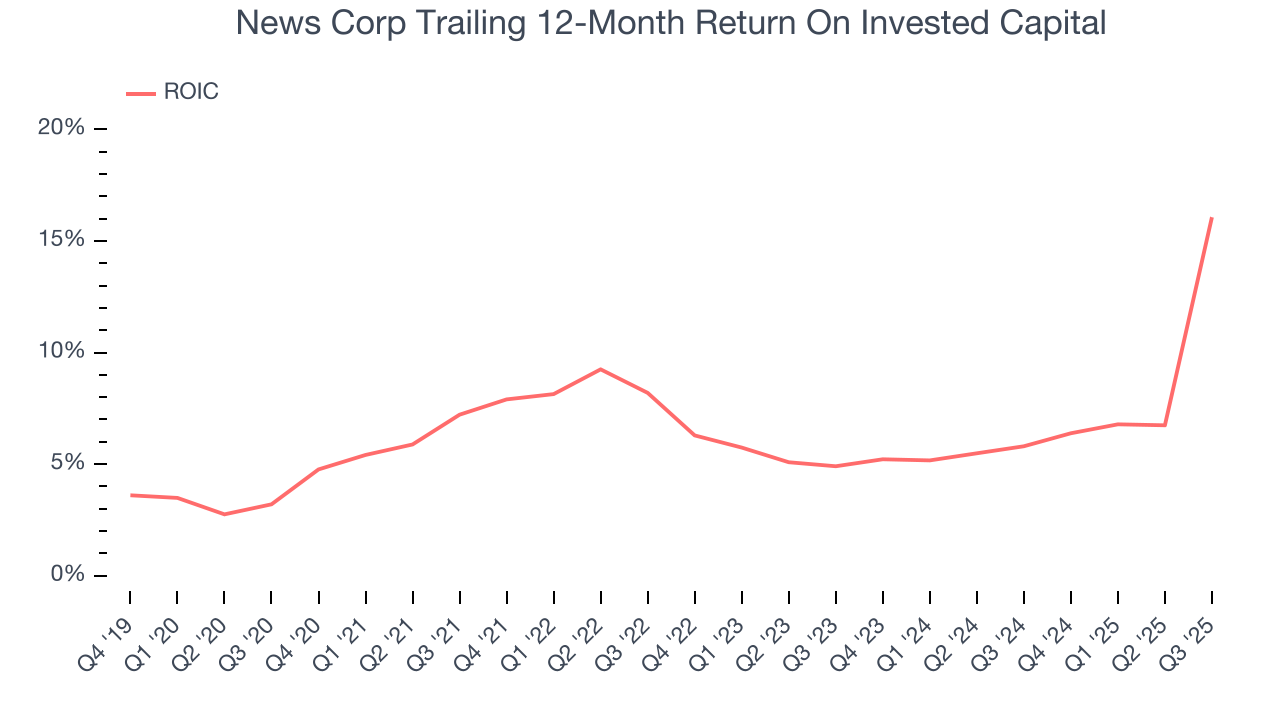
We like to invest in businesses with high returns, but the trend in a company’s ROIC is what often surprises the market and moves the stock price. On average, News Corp’s ROIC increased by 3.2 percentage points annually over the last few years. This is a good sign, and we hope the company can continue improving.
10. Balance Sheet Assessment
News Corp reported $2.20 billion of cash and $2.86 billion of debt on its balance sheet in the most recent quarter. As investors in high-quality companies, we primarily focus on two things: 1) that a company’s debt level isn’t too high and 2) that its interest payments are not excessively burdening the business.
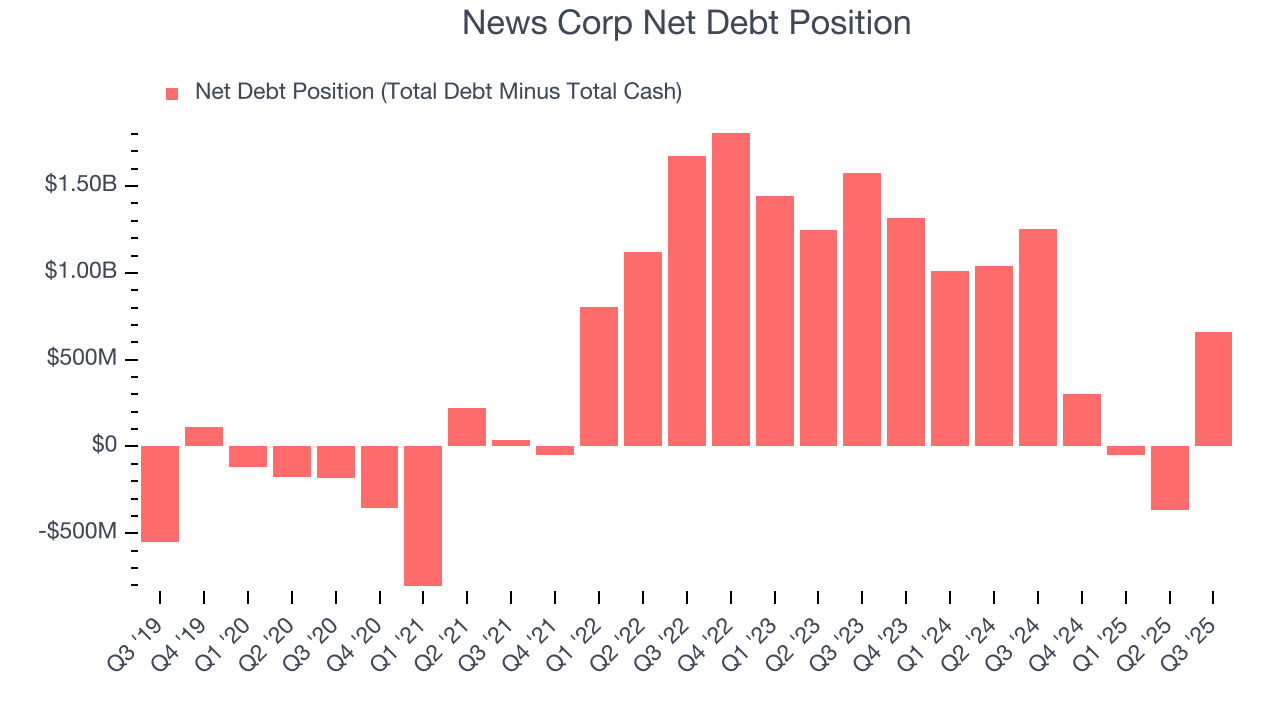
With $1.44 billion of EBITDA over the last 12 months, we view News Corp’s 0.5× net-debt-to-EBITDA ratio as safe. We also see its $2.99 million of annual interest expenses as appropriate. The company’s profits give it plenty of breathing room, allowing it to continue investing in growth initiatives.
11. Key Takeaways from News Corp’s Q3 Results
It was good to see News Corp beat analysts’ EPS expectations this quarter. We were also happy its revenue outperformed Wall Street’s estimates. Overall, this print had some key positives. The stock remained flat at $25.08 immediately after reporting.
12. Is Now The Time To Buy News Corp?
Updated: December 4, 2025 at 9:03 PM EST
We think that the latest earnings result is only one piece of the bigger puzzle. If you’re deciding whether to own News Corp, you should also grasp the company’s longer-term business quality and valuation.
News Corp doesn’t pass our quality test. To kick things off, its revenue growth was weak over the last five years. On top of that, News Corp’s projected EPS for the next year is lacking, and its relatively low ROIC suggests management has struggled to find compelling investment opportunities.
News Corp’s P/E ratio based on the next 12 months is 26.1x. This valuation tells us a lot of optimism is priced in - we think there are better stocks to buy right now.
Wall Street analysts have a consensus one-year price target of $36.69 on the company (compared to the current share price of $25.63).
Although the price target is bullish, readers should exercise caution because analysts tend to be overly optimistic. The firms they work for, often big banks, have relationships with companies that extend into fundraising, M&A advisory, and other rewarding business lines. As a result, they typically hesitate to say bad things for fear they will lose out. We at StockStory do not suffer from such conflicts of interest, so we’ll always tell it like it is.







